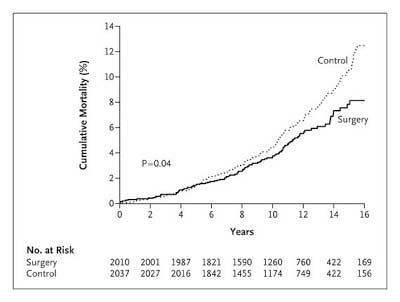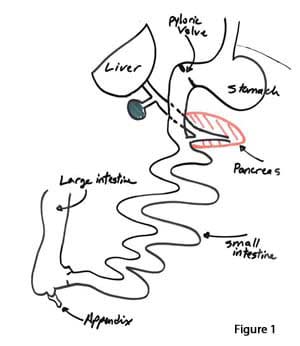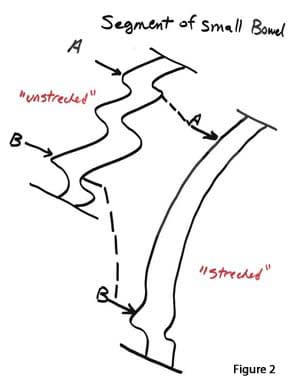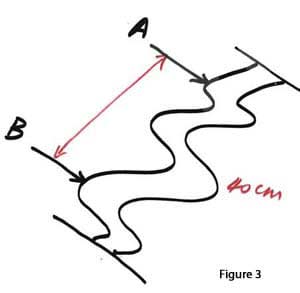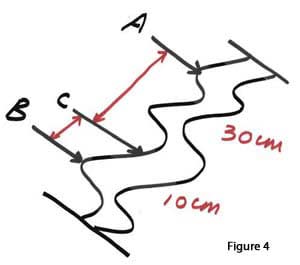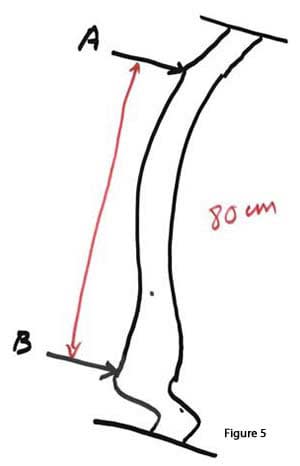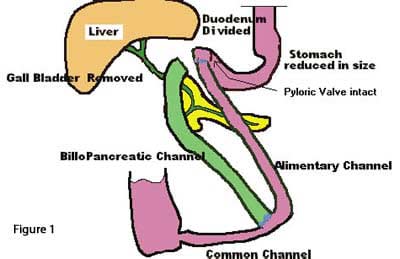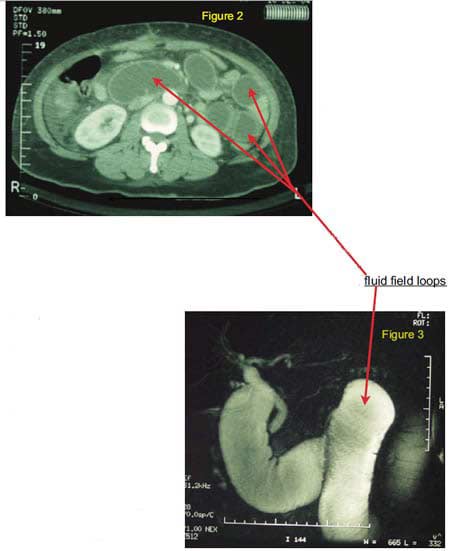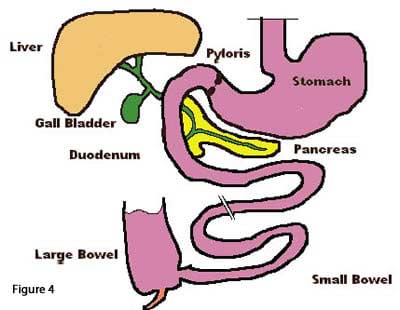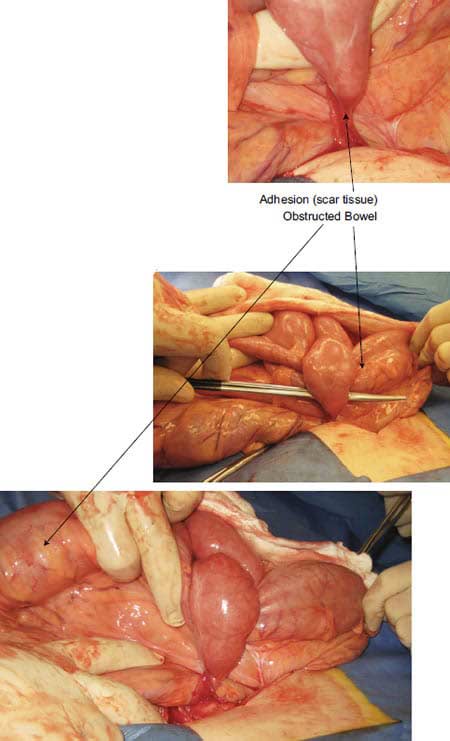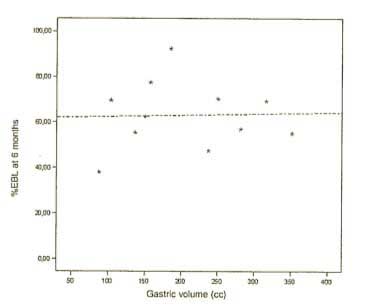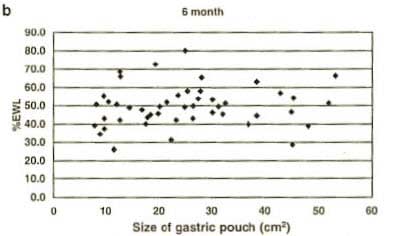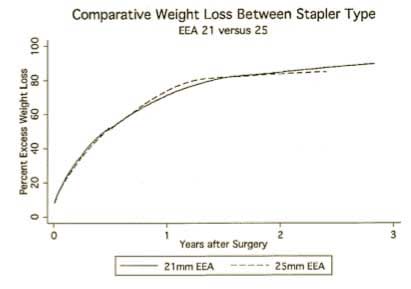Summary of Selected Presentations of ASMBS Meeting Part 3
August 23, 2010 10:36 am
Laparoscopic Roux-En-Y Gastric Bypass Achieves Greater Weight Loss than Sleeve Gastrectomy after One Year
Surgery, Kaiser Permanente South Bay Medical Center, Harbor City, CA; Surgery, Harbor –UCLA Medical Center , Torrance, CA; Emergency Medicine, Harbor- UCLA Medical Center, Torrance , CA
Laparoscopic sleeve gastrectomy (LSG) has become very popular as a weight loss surgery. This study was conducted to portray similarities of LSG to ROUX-En-Y Gastric Bypass (RYGB) results. Patients who had the RYGB and LSG from 2007 to 2009 were analyzed for % excess weight loss (EWL), resolutions for co-morbidities, postoperative problems and mortality. Laparoscopic RYGB and LSG have comparable postoperative morbidity and mortality rates
Editorial: There is lots excitement about the sleeve gastrectomy. It is worthwhile to remember that as Duodenal surgeons, we have performed sleeve gastrectomy with every duodenal switch operation. At the beginning the sleeve gastrectomy was offered as a staging operation for hight risk Duodenal switch patients. The rationale was that by offering sleeve gastrectomy as a first part of the duodenal switch operation,a patient can loose some weight, and make the second part of the operation much less risky. It was with this observation then some surgeons started promoting sleeve gastrectomy as a primary operation. The long term data for sleeve gastrectomy is very limited. In my opinion, sleeve gastrectomy is a great alternative for some patient instead of the Lap Band®, since it does not involve placement of foreign body, and will not require adjustments. With all these information in mind, I would like to remind ourselves that all surgeries have their own drawbacks, and the only way a patient can make an informed educated decision is to know what their options are, and not be just told about one surgery.
Ara Keshishian, MD
| RYGB (n=345) | Sleeve (n=192) | P Value | |
Median Age |
46 | 48 | 0.05 |
Median BMI kg/m2 |
47 | 43 | <0.0001 |
| Median length of hospital stay | 3 | 3 | 1 |
| DM - number and (%) of patient that had DM | 112 (32%) | 42 (22%) | 0.01 |
| Remission of DM | 73 (65%) | 31 (74%) | 0.3 |
| HTN - number and (%) of patient that had HTN | 199 (58%) | 102 (53%) | 0.3 |
| Resolution of HTN | 95 (48%) | 35 (34%) | 0.003 |
| GERD -number and (%) of patient that had GERD | 83 (24%) | 53 (28%) | 0.4 |
| Resolution of GERD | 61 (73%) | 18 (34%) | < 0.0001 |
| Median EWL at one month | 9.7% | 9.20% | 0.05 |
| Median EWL at 3 months | 12.90% | 16.20% | <0.0001 |
| Median EWL at 6 months | 19.50% | 22.50% | < 0.0001 |
| Median EWL at 12 months | 28.90% | 25.90% | < 0.0001 |
| Total complications | 43 (12%) | 21 (11%) | 0.6 |
| Mortality | 1 (0.3%) | 0.00% | 1 |
Summary of Selected Presentations of ASMBS Meeting Part 2
August 17, 2010 10:33 am
Is Weight Loss Better Sustained With Long Limb Gastric Bypass in the Super Obese?
Columbia University at Harlem Hospital Center, New York, NY
Gastric bypass with Roux limb length of 150 cm has shown better weight loss in patients with a BMI greater than 50, but the ideal length of the Roux limb is not yet agreed upon. This study was conducted to compare long-term weight loss and weight regain of standard limb length (SLL) and long limb length (LLL). 120 patients with a BMI greater than 50 went through the SLL or LLL gastric bypass. The weight regain and the rate of complications were followed up for years 1, 2, and 3 after surgery. The authors concluded, there was no apparent difference in demographics, preoperative BMI measurements, or comorbidities. In comparing SLL to LLL preoperative BMI was around 56 and there was no difference in percentage weight regain. Also, typical complications such as bleeding and leakage were also parallel. Hence, there is no apparent distinction between SLL and LLL gastric bypass operations, with regards to the percentage weight regain.
Editorial: There were a few studies presented at the meeting that looked at the distal gastric bypass operation. There has been a resurgence of this operation recently. I would suggest that the standard gastric bypass has a high failure rate and conversion to distal bypass appears to be an easy solution. This study demonstrated that there was not a significant difference between the long limb or the short limb gastric bypass. There does however undisputed increase in the metabolic complications of the distal gastric bypass.
Ara Keshishian, MD
Area Laparoscopic Bariatric Procedures Safe in Super Obese Patients? A NSQIP Data Analysis
Department of Surgery, New York Hospital Queens, Flushing, NY
This study was conducted to test the safety of the Laparoscopic Bariatric Procedure in super obese patients. 29,300 patients who underwent LBP were separated into two groups having a BMI greater than 50 and less than 50. Patients who underwent Laparoscopic Gastric Bypass (LGB) and Laparoscopic Adjustable Gastric Band (LAGB) were used as the basis for the study. As a result, in the BMI >50 Kg/ m2 group there were more males, younger patients, and higher occurrences of HTN and Dyspnea. In both procedures the group of people whose BMI was greater than 50 had an elevation in complications. As a result, patients with a BMI of less than 50 have less chance of complications and mortality when compared to super obese patients.
Primary and Revisional Laparoscopic Adjustable Gastric Band Placement in Patients with Hiatal Hernia Surgery
University of Nebraska Medical Center, Omaha, NE
In this case study the regularity of hiatal hernia and the safety of restoring and revising LAGB was assessed. Many physicians restore a hiatal hernia at the time of the Laparoscopic Adjustable Gastric Band (LAGB) placement. Data from the CDB/RM (Clinical Data Base/ Resource Manager) was used for LAGB with and without hiatal hernia during a three year time span to conduct this experiment. In LAGB operations 19% of patients had a hiatal hernia compared to 26% in the repair surgery group. As a result, hiatal hernia repair was carried out with LAGB in 12% of the patients. Mortality, length of stay, and morbidity was about the same in cases undergoing hiatal hernia restoration with initial LAGB versus non hiatal hernia repair patients. Statistics show, that morbidity was quite less when hiatal hernia was renovated in the primary operation in comparison to adjustment surgery. Occurrence of a hiatal hernia is linked with an increased rate of revisional surgery and a rise of morbidity following LAGB. All in all, hiatal hernias are best mended with primary LAGB.
Summary of Selected Presentations of ASMBS Meeting Part 1
August 13, 2010 10:30 am
Protein Intake Compliance of Morbidly Obese Patients Undergoing Laparoscopic Roux-en-Y Gastric Bypass and its Effect on Weight Loss, Leptin and Albumin.
Bariatric Center, Saint Francis Hospital and Medical Center, Hartford, CT; Pediatrics and Surgery, Saint Francis Hospital, Hartford, CT
Low daily protein intake (DPI) after laparoscopic Roux-en-Y Gastric Bypass (LRYGB) has been reported. This presentation discussed the DPI measurements after the LRYGB procedure and its effect on weight loss, leptin and albumin levels. Two hundred thirty LRYGB patients were taken into consideration for this study. There were 200 females with a mean age of 41 years old and an average BMI of 47 kg/m2. There was an apparent correlation of DPI with the lowest BMI after a year. However, in patients with a higher DPI after a year, there was a large leptin level drop and a greater BMI drop, determining no increase in serum albumin. As a result, higher DPI benefits weight loss and nutritional status a year after LRYGB surgery.
Editorial: The take home message is that the higher the protein intake the better the weight loss in gastric bypass patients. I am not aware of a similar study for Duodenal Switch patients but I would venture to guess that the parallel also applies to the Duodenal Switch patients.
Ara Keshishian, MD
Laparoscopic Sleeve Gastrectomy in Adolescents, Results in 51 Patients
Pontificia Universidad Catolica de Chile, Santiago, CHILE
It’s an unfortunate fact that such a majority of today’s adolescents develop obesity and develop multitude of medical and psychosocial problems. This particular research was done to investigate the observations and execution of the Laparoscopic sleeve gastrectomy (LSG). 50 patients were analyzed and studied from the beginning of 2006 till late 2009 examining % excess weight loss (%EWL) and the teenagers’ general happiness. Many of the cases werefemales averaging 18 years old with an approximated BMI of 36. Of these patients many were diagnosed with comorbidities. The LSG has proven to be a dependable and accomplishedsurgery resulting in 95% weight loss after a year and a half leaving 76% of patients with resolved co morbidities. Most importantly, this allowed the adolescents to have a better outlook on life and more self-esteem for themselves. The sleeve gastrectomy is proven to be a safe approach with favorable weight loss data along with an effective resolution of obesity.
Editorial: Note that the outcome data is only for 1.5 year. As with all weight loss surgical procedures it is very important to look at what happens to the patients long term over 5-10 year period and not over the short term. As one of the issues that was noted in a number of presentations, there is still no uniform baseline reporting in place. Different procedures all claim to be successful, yet when you look at the fine print some had a follow up of months and other years.
Ara Keshishian, MD
Interim Outcomes Report of Adjustable Gastric Banding In 402 Adolescents at a Single Center
Jacksonville Surgical Associates, Jacksonville, FL
Adolescent obesity is on the rise and is one of the major problems teens face today. The purpose of this study was to analyze the safety and success rate ofthe Lap band in America’s youth. Four hundred patients aged 10 to 20 years old were used in this case because they had the gastric band surgery performed. The study recorded complications, weight loss and demographics. The average BMI (3:1 ratio for women to men), was 43. The study also showed that there was a general reduction in associated comorbidities. In summary, adolescent adjustable gastric banding is effective at minimizing weight and keeping it off with a very low rate of drawbacks in the future. This information may later be used to initiate a weight loss program to reduce adolescent obesity.
Vitamin D Structure
July 30, 2010 10:41 pm
Walking out into the daylight we sometimes complain about the sun’s rays hit our eyes or burning our skin. Most people overlook the importance of the sun, for they are unaware of its benefits. Vitamin D is a natural resource produced from the ultraviolet light waves from the sun hitting our skin. As a result, this allows normal bone growth and development to take place. In addition, vitamin D can be found in various foods, such as seafood and milk. Also, vitamin D’s main function is to maintain consistent levels of calcium and phosphorus.
What are the major sources of vitamin D?
The major sources are food and exposure to sunlight. Important food sources are:
- Fortified foods with major dietary sources of vitamins and minerals. For example, Milk in the United States is reinforced with 10 micrograms (400 IU) of vitamin D per quart.
- Fatty fish and fish oils.
Exposure to sunlight is an important source of vitamin D as well. Ultraviolet (UV) rays from sunlight generate vitamin D composition in the skin. There is some evidence that the body can make 10,000 iu to 25,000 iu in a single short sun exposure if the sunlight is adequate and appropriate amount of skin is exposed.
What is Vitamin D’s function? Calcium and phosphorus are two vital minerals which are constantly controlled and conserved by vitamin D in our bodies. Calcium is responsible for managing our body’s bones and keeping them stable. In addition to keeping our bones healthy, phosphorus assists with keeping nerves and muscles working together efficiently. In many countries, such as Alaska where sunlight is scarce, many people develop skeletal deformities, or muscular vulnerability. Without vitamin D, bones can become brittle and soft, also known as rickets.
Lack of Vitamin D Minimal amount or deficiencies are major causes of rickets and osteomalacia. An absence of vitamin D develops when dietary intake is insufficient, little exposure to sunlight, the kidneys not modifying it to its active form, or when the individual isn’t capable of absorbing vitamin D from the gastrointestinal tract. In addition, Americans over the age of 50 may be at risk of deficiency because the ability of skin to manipulate vitamin D into its active form slows as we grow older. As a result of various diseases the reduction of a person’s ability to absorb dietary fat decreases. Also, the kidneys which convert vitamin D to its malleable form decrease in efficiency as well. This is a brief over view of the many functions and uses of this important vitamin. Over the last few years there has been a wealth of information that has been published.
Excess Vitamin D Too much vitamin D can cause nausea, vomiting, poor appetite, constipation, weakness in fatigue, pain in the bones and weight loss. Also, vitamin D stimulates the formation of kidney stones, stiffening of soft tissue, and rise in blood levels of calcium. It is however realize that being that vitamin D is a fat soluble vitamin, it is very hard, if not impossible to get excessive amount of calcium after Duodenal switch operation. In order to avoid this very rare complication, patients on Vitamin D supplements should have their Vitamin D 25-OH levels check regularly.
Difference between D2 and D3 Vitamin D is present in two forms, cholecalciferol (D3) and Ergocalciferol (D2). D2 is manufactured by plants or fungus. D3 is formed by the body as a result of sunlight exposure and to some degree by animal products. Other differences about them is that D3 has a longer shelf life, and D2 can be toxic in most patient at high doses. Most of the beneficial effects of the Vitamin D have been contributed to D3. Further discussion here.
Questions that were posted on the obesity help website
January 25, 2010 4:33 am
Obesity Help Questions:
Here are several explanations to a question that were posted on the obesity help website:
The Swedish Obese subject group of studies (SOS studies) have been looking at a lot of the questions that are raised.
 1.) Diet and exercise in relation to weight loss surgery. The study found weight loss surgical procedures far more superior to the conventional diet and exercise plans. Their original data offered a relationship between the nonsurgical method and the RNY gastric bypass, VBG, and banding procedures. The long-term outcomes in 15 years of data were plotted and it is significant that the control (the nonsurgical group) had no sustained weight loss.
1.) Diet and exercise in relation to weight loss surgery. The study found weight loss surgical procedures far more superior to the conventional diet and exercise plans. Their original data offered a relationship between the nonsurgical method and the RNY gastric bypass, VBG, and banding procedures. The long-term outcomes in 15 years of data were plotted and it is significant that the control (the nonsurgical group) had no sustained weight loss.
2.) The follow-up question was asked to find if there are any life-extending benefits to weight loss surgical procedures. This is a question that has only recently been answered, since it takes time to know if patients who have had weight loss surgery live longer or not. The published data in NEJM in 2007 by the SOS group answered this same specific question.
Ara Keshishian, MD, FACS, FASMBS
The graphs are from https://content.nejm.org/cgi/content/full/357/8/741
Duodenal Switch and Distal Gastric Bypass (ERNY)
December 04, 2009 7:24 pm
On 10/28/2009 I had a variation of the RNY gastric bypass (Distal Gastric Bypass) known as the Fobi pouch. I lost over 270 pounds, but I had debilitating complications of dumping syndrome, reactive hypoglycemia, acid reflux and vomiting.
My entire day was pretty much controlled by dumping syndrome. Due to the hypoglycemic episodes that resulted from dumping syndrome, I was constantly in a binge cycle, because I constantly needed to stabilize my blood sugar. I would eat breakfast and need to lay down. Once I started having hypoglycemia, I would get up and splurge on carbohydrates.
Note that my dumping syndrome was not caused by poor food choices. I only splurged off carbohydrates in a desperate attempt to quickly get my glucose levels up. This did work, but it lead me to dumping syndrome again. I then had another episode of hypoglycemia, which lead to more binging which resulted in more dumping, more binging and weight gain. Here is a diagram of the cycle I was constantly in:
Eat –> dump –>hypoglycemia –> binge –>redump –> more hypoglycemia –> binge –> dump
This was a constant cycle I was in, and as you can see here, my entire life became controlled by dumping syndrome, and it eventually caused me to become disabled. I am a full time student and was not able to go to school in this state. I would eat lunch and then go to class only to start dumping ten minutes into lecture, and I ended up dropping my classes for the semester.
I went to my bypass surgeon and told him of the problems I was having, and he told me that I was anorexic. I was also told that it was “…all in my head.”
After doing much research, I consulted with Dr. Keshishian. I handed him a list with the problems I was having and asked if revision to the duodenal switch would resolve these problems. Dr. Keshishian drew out a diagram of the anatomy of my surgery and showed me exactly why I was having these complications. I remember him saying, “There is a physiological explanation for why you are having these problems. It is not in your head. Yes, revision will resolve these complications.”
I had my revision on 4/11/2011, and all the complications I had with my bypass have been resolved, and I have had no complications with my duodenal switch. Now that my pylorus is working again, I can eat without becoming ill. I have now gone back to school, work, and have resumed back to a normal life.
YG
Obesityhelp.com revision Forum information
November 08, 2009 9:00 am
I am not sure what has happened over the past two weeks or so, but I have received a number of inquiries from patients who have had questions about the revision of RNY or Lap Band® for weight regain, inadequate weight loss, or other complications. I finally had to ask one of the patients where he got his information and heard about our practice. His source of information was the obesityhelp.com website.
I have spent some time looking over and responding to several postings on the forum sites. I have referred to a number of publications in some of my postings on obsityhelp.com.
Nishie et.al. (Obesity Surgery, 17, 2007 1183-1188) reported:
“Pouch size area, measured by routine UGI on the first postoperative day does not influence short term postoperative weight loss. “
Cottam et.al. (Obesity Surgery 2009, 19:13-17) concluded:
“The level of restriction or the presence of stenosis achieved by different stapler sizes does not have a significant role in weight loss.”
O’Connor et.al. (Surgery for Obesity and Related Dis. 4(2008) 399-403) summarizes:
“With construction of divided, vertical, lesser curvature based small-volume (less than or equal to 20 cm gastric pouches, the actual size of the gastric pouch did not correlate with the %EWL at 1 year laparoscopic GB.”
I am a firm believer that the best patient is the most knowledgeable patient. It is always safer to spend as much time as needed to ask questions and investigate all options. If I can provide any information, please contact us at contact@dssurgery.com
Length of Small Bowel
October 26, 2009 2:49 am
It appears that there are series of questions and concerns that are not completely resolved, and they resurface every so frequently. Length of the small bowel for the Common Channel and the Alimentary limb in the Duodenal Switch operation is one of those topics.
The Questions that I am asked:
- How long is my common Channel?
- Another patient had the same length, but they are loosing more (or less) as the case may be.
- I was told by another surgeon that they would give me a certain length of common channel, what do you think?
The common problem is that there is no accurate and practical way to measure the length of the bowel. There is also two schools of though, with very little objective research to support one or the other. There is no published data that I could find that answers this question head on. There are number of other
articles, and presentations that touch on this topic.
The best reference that I think is worth looking over is an editorial by Dr. Hess. The link is provided below.
I would like to discuss this in an organized way.
The artistic work is done by yours truly!
First a Brief over view of our GI track:
Our GI track starts at the mouth and ends in the rectum (figure 1). It is a long tube that has a very few side branches. These include the opening of the salivary glands in the mouth, the opening of the biliary (from the liver) and the pancreatic (from the pancreas) plumbing to in the first part of the small bowel
(duodenum) and the Appendix (at the junction of the small bowel and the large bowel).
Related article is available on our site.
The small bowel is the part that causes all this confusion. The small bowel is a long pliable, elastic tube that can be stretched (figure 2).
Depending on how much force is applied to it, it can be of different lengths. A similar analogy is the phone cord to head set of a conventional phone. The spiral cord placed on a table will coil up to a certain length. If one then pulls on two ends it will measure longer. And if more pull is exerted, then it will easure even longer. This demonstrates that the absolute measured length of the small bowel, is directly related to the force with which it is pulled. What this means is that if two individuals measure the length of the headset cord, or the bowel, they will get two different lengths, both correct but not the same. The length is directly proportional to the pull force applied to both ends.
Furthermore; the length of the small bowel is determinant of the absorptive capacity (amongst other factors). The longer the small bowel the more absorption, and the shorter the small bowel, the less absorption. There is a general-trauma surgical problem knows as short gut syndrome, where the length of the bowel is so short that it cannot support maintenance of the electrolytes and minerals, in additions to the required absorption of the calories. Short gut syndrome is a very difficult surgical problem to solve.
Getting back to our discussion however, we can now appreciate how two
surgeons can measure the same amount of small bowel (the same absorptive capacity) but end of with different lengths of small bowel. Same amount of bowel, same absorptive capacity, different lengths. This is why comparing lengths of small bowel is probably not the most accurate way to. Two patients, both with 75 cm common channels may have very different absorptive capacity, unless the bowel was measured by the same surgeon, and both patients had the same amount of total bowel length. We should next consider a possible alternative. Consider the drawing on (figure 3) and (figure 4).
The distance between C and B is 25% (quarter) of the total length between A and B. This represents a segment of bowel that was measured and marked Now lets take the same amount of bowel and apply a little more pull force to the ends while measuring it. We will have a total length of 80 cm, between A and B (figure 5). The distance between A and C will be 60 cm and the distance between C and B will be 40 cm (figure 6). The absolute lengths then are double of the first case. Same amount of bowel, same absorptive capacity yet double the length. Does this mean that the second patient with distance between C and B at 20 cm will absorb twice as much as the first patient? The answer is no, since it was the same amount of bowel that was measured with different technique.
Lets now however look at this from another perspective. In both cases the distance between C and B was only 25% of the total length.
| Distances | Figures 3 & 4 | Figures 5 & 6 |
| Total length A-B | 40 cm | 80 cm |
| A-C | 30 cm | 60 cm |
| % of total | 25% | 25% |
The table above shows why lengths of bowel discussed in-terms of percentage of total may be a more standardized than the absolute numbers.
In this example both patient will have same absorptive capacity (25%) yet will have much longer absolute lengths. In our practice, we measure the total length and the common channel and the alimentary lengths are based on the patient BMI, comorbidities, age, sex, and activity level.
Please remember that this is only my opinion, different surgeons do it differently.
Bowel Obstruction From “scar” Tissue
October 12, 2009 7:52 pm
One of the potential complications of any abdominal surgery is bowel obstruction. This can occur with open or laparoscopic operation. It can also occur within days or years of the operation. The over all incidence of bowel obstruction is relatively low.
The text book diagnostic criteria for bowel obstruction is the presence of a set of physical findings additional to the diagnostic supporting evidence. A typical patient may present with cramping abdominal pain, nausea, vomiting, absence of any flatus, and not bowel movements. The pain may be dull and could be any where on the abdomen. The White count may be elevated, and a plain abdominal Xray may show “airfluid” levels. All of these finding point to a patient that has bowel obstruction. Depending on the age and the history of the patient, the a common cause may he adhesions (scar tissue) that has cause a blockage of the bowel.
Unfortunately, these physical and radiological findings may not all be present in patients that have had the Duodenal Switch or the Gastric Bypass operation. The patients may complain of nausea but no vomiting. They may still pass gas and have bowel movements, but have cramping abdominal pain. The plain abdominal xray may not show air-fluid levels, yet have complete obstruction. The presence or lack of these findings can be explained.
In both the DS and the RNY operations, there are two parallel limbs (figure 1). One of them is connected to the esophagus, thus it can have air in it. The other limb is not connected to the outside on the proximal end (green limb in figure one only drain the bilio-pancreatic secretions and is not connected on the proximal end to the esophagus). This major anatomical difference explains why there may be air fluid level in a bowel obstruction patient with no DS or RNY, and no such finding in a DS or RNY patient.
The most important diagnostic tool is a very high degree of clinical suspicion. The absence of vomiting, or air fluid levels on an abdominal xray, or the presence of flatus and bowel movements does NOT rule out a complete bowel obstruction. The more reliable way to diagnose a bowel obstruction after DS or RNY is by CT scan or and MRI (figure 2, 3).
A finding of fluid field loops of bowel is highly specific for bowel obstruction and warrants a surgical intervention since it can not be corrected by a naso-gastric tube (tube inserted thru the nose into the stomach to decompress the stomach and the proximal small bowel). This is because as mentioned earlier, there is a parallel segment of bowel that is not in continuum with the esophagus. In pre DS or RNY anatomy, the entire GI track is a long tube (figure 4).
An example of a bowel obstruction caused by scar tissue is noted in the following pictures.
Does Size Matter
September 28, 2009 12:14 pm
The scientific basis for weight loss surgery, for the majority of the part relies on the premise that overeating and lack of exercise are the principal mechanisms contributing to the increase in the incidence of obesity over that last decade. Much has been said about our unhealthy life style that involves sedentary activity and immobility. Fast foods, high fat content meals, calorie dense food, are some of the examples of possible contributing factors to this health crisis.
The contrary position would be that there are other factors that contribute to obesity. These may include environmental factors, food preservatives, genetics, and exposures to toxins.
If one assumes that the over eating is the core problem, then you can also assume that the most successful operation will have the smallest stomach, since it will reduce the ability to over eat most drastically. This is where the scientific evidence does not support the theory and we all have to reassess the principal that the treatments are directed toward.
Recently there have been a number of studies that have been published in scientific journals that suggest size of the stomach or the pouch does not matter. So if obesity is the result of over eating then the operation that provides the smallest stomach must work the best. This argument should be true for the pouch size after gastric bypass, and the opening of the gastro-jejunostomy (connection between the stomach pouch and the small bowel connected to it after the gastric bypass, RNY operation). The same theory applies to the sleeve gastrectomy of the duodenal switch operation.
This argument that over eating and lack of exercise is the major contributing factor seems to be loosing ground.
The studies below are outline to demonstrate the disparity between the theory and the lack of scientific support for it.
1- Sanchez-Pernaute et.al. (Obesity Surgery, 17, 2007) reported that “After DS, gastric tube volume is not directly related to weight changes.” He proposed that there are other factors that may contribute to the weight loss than the size of the gastric tube.
This graph taken from the referenced study above shows that the size of the stomach sleeve does not correlate with the %EBWL in DS patients. The smaller stomach sleeve does not result in the more weight loss.
2- O’Connor et.al. (SOARD 4(2008)399-403) reported that “With construction of divided, vertical, lesser curve-based small-volume (=<20cm3) gastric pouches, the actual size of the gastric pouch did not correlate wit the %EBWL at 1 year after Laparoscopic, GB [gastric bypass]”.
3- Nishie et.al. (Obesity surgery, 17, 2007) concluded that “pouch size area, measured by routine UGI [upper GI series] on the first post operative day, does no influence short-term postoperative weight loss”.
This a sample of a number of graph that Nishie published in her study. The similar graphs were for 3, 12, and 24 months. They all had a flat line distributions. What they are showed was regardless of the time lapsed from surgery, the %EBWL was independent of the size of the pouch measured immediately post operatively.
4- Cottam et.al. (Obesity Surgery, 2009, 19:13-17) reported “The level of restriction or the presence of stenosis achieved by different circular stapler sizes does not have a significant role in weight loss”.
This study was focused on the size of the opening that is made between the stomach pouch and the small bowel in the gastric bypass (RNY) operation. The weight loss did not differ in the two groups of the patients. One group had a 21mm stapler and the other one 25mm stapler used. The weight loss, as measured by %EBWL was nearly identical in both cases.
In summary, the size does not seem to matter. The size of the stomach pouch, when it gets to a certain size in not important. The smaller stomach pouch or the narrower connection of the stomach and the small bowel will not make a patient loose more weight. Doesn’t this prove, to at least some degree, that there is much more to obesity than the simple notion of eating small portion and exercising?


